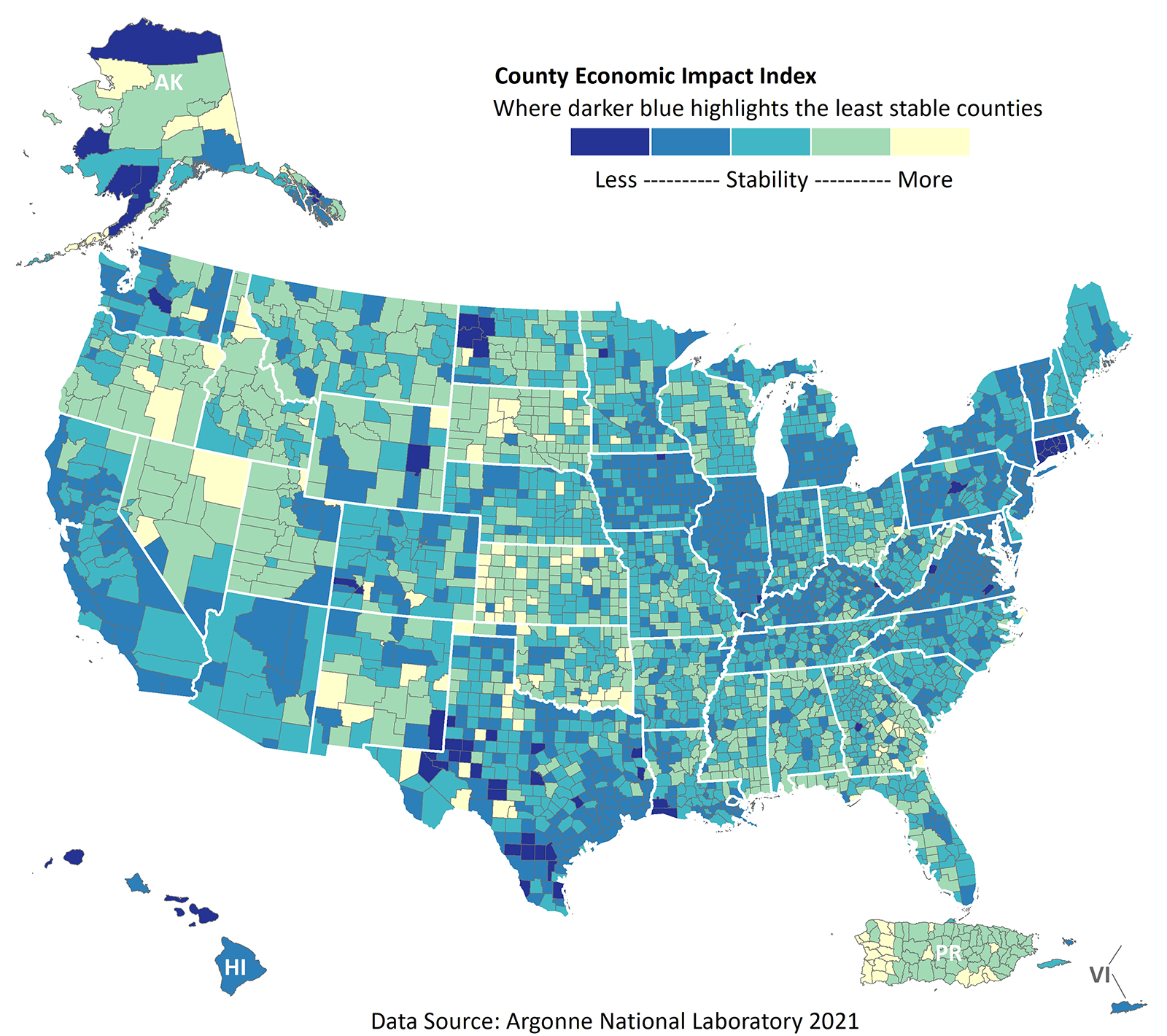Read the Whitepaper | Download the Data | Visit the Story Map
The goal of the County Economic Impact Index (CEII) is to identify regions whose local economies may be more adversely affected during medium- to long-term disruptions with near real-time data.
What is the County Economic Impact Index (CEII)?
Disruptive events, including the COVID-19 pandemic, often result in significant changes in employment, personal income, industry output, and other measures of economic well-being and activity. Depending on the nature of the disruption, economic consequences can be relatively short-lived or they can linger for months or years. Argonne National Laboratory (Argonne) developed the CEII to track near real-time impacts to local economies across the United States. The CEII also provides insight into economic recovery over time. A CEII value of 1 indicates that a county’s economy is in the same position as it was in January 2020, while scores below 1 indicate that it is worse off and scores greater than 1 indicate that it has since grown. It does not account for economic growth that would have happened under normal circumstances that did not occur.
What Does the CEII Measure?
The CEII estimates the change in overall county-level economic activity during the COVID-19 pandemic relative to January 2020. It shows which counties may be more susceptible to large reductions in economic activity compared to normal conditions by looking at which industries make up each county’s economy and then tracking monthly changes in industry employment at the national level. Economic activity in the CEII is measured by the total value added of all industries within the county, also referred to as the county’s Gross Domestic Product (GDP)1. Accordingly, the CEII data also includes annualized monthly estimates of county-level value added for more than 100 industries. Counties with economic activities dominated by industries experiencing rising unemployment can expect larger direct impacts to their local economies, particularly if the industries account for a large portion of the economic output of that county. Results are updated monthly and available for all U.S. counties, as well as the District of Columbia, Puerto Rico municipios, and the U.S. Virgin Islands.
Why Is the CEII Important?
The CEII provides the ability to monitor trends over time of the economic health of counties in the United States. One way to measure overall economic activity in a region is through its gross domestic product (GDP), or the monetary value of all final goods and services produced in an economy in a given year. GDP can also be thought of as the total sum of the value added by each industry in an economy. Higher GDP values are associated with more economic activity in a region, while lower values are associated with less economic activity. For this reason, GDP is often used as an assessment of an economy’s overall size and health. While not a perfect indicator of overall economic wellbeing, increasing GDP over time generally implies an economy is experiencing more economic activity (i.e. more production of final goods and services, higher levels of personal expenditure and investment, higher wages and profits, government purchases, etc.). Decreases in GDP may imply that an economy is experiencing higher levels of unemployment, lower wages, lower profits, and overall less production and spending in the economy. As such, CEII values lower than 1 imply that more people are unemployed (due to fewer jobs) and businesses are producing and earning less than they were prior to COVID-19.
How Can I Use the CEII?
You can use the CEII storymap to check on the current or trending economic situation in your local area. From the “Economic Index” tab at the top, clicking on your county will give you a pop-up box that provides the Economic Index calculation (EconomicIndex[month]) by month. Darker shades indicate less stable economies, while lighter shades indicate more stability.
Learn more about REST Services
Argonne National Laboratory’s work is supported by the U.S. Department of Homeland Security, Federal Emergency Management Agency, via interagency agreement through U.S. Department of Energy contract DE-AC02-06CH11357. FEMA does not endorse any nongovernment entities, organizations, or services.
